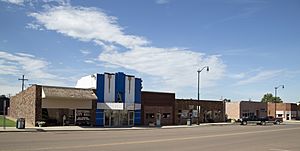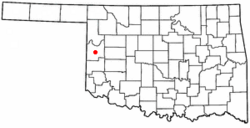Cheyenne, Oklahoma facts for kids
Quick facts for kids
Cheyenne, Oklahoma
|
|
|---|---|

Cheyenne town center
|
|

Location of Cheyenne, Oklahoma
|
|
| Country | United States |
| State | Oklahoma |
| County | Roger Mills |
| Area | |
| • Total | 0.99 sq mi (2.56 km2) |
| • Land | 0.99 sq mi (2.56 km2) |
| • Water | 0.00 sq mi (0.00 km2) |
| Elevation | 1,946 ft (593 m) |
| Population
(2020)
|
|
| • Total | 771 |
| • Density | 780.36/sq mi (301.40/km2) |
| Time zone | UTC-6 (Central (CST)) |
| • Summer (DST) | UTC-5 (CDT) |
| ZIP code |
73628
|
| Area code(s) | 580 |
| FIPS code | 40-13900 |
| GNIS feature ID | 2413196 |
Cheyenne is a small town in Roger Mills County, Oklahoma, United States. In 2020, about 771 people lived there. It is the main town, or county seat, of Roger Mills County.
Contents
History
Cheyenne is famous for the Battle of Washita River. This event happened on November 26, 1868. During this battle, George Armstrong Custer and his soldiers attacked a Cheyenne village. The village was led by Black Kettle and was located along the Washita River.
Cheyenne has been the county seat since 1895. In 1912, a railroad was built nearby, ending at Strong City. Strong City hoped to become the new county seat. To keep its important position, Cheyenne built its own short railroad line. This line connected Cheyenne to the main railroad at Strong City.
In 1914, the courthouse in Cheyenne burned down. People in Strong City again hoped to get the new courthouse built there. But Cheyenne raised money and built a new, two-story brick courthouse. Strong City tried to compete for a while. In the 1930s, many businesses moved from Strong City to Cheyenne. This caused Strong City to lose people and businesses, while Cheyenne grew.
During the 1970s, Cheyenne and the area around it grew. This was thanks to the discovery of natural gas and oil. These resources were found in the Panhandle-Hugoton field. This field is one of the largest gas fields in the United States. It is also the world's biggest source of helium. Between 1973 and 1993, the field produced a huge amount of gas.
Amazing Basketball Teams
Cheyenne High School has had some very successful basketball teams.
Lady Bears (1985–1987)
The Cheyenne High School girls' basketball team, called the Lady Bears, had an amazing run. From 1985 to 1987, they won three state Class A championships in a row. They had a record of 88 wins and only 4 losses during this time. They even won their last 42 games straight! Before 1985, the team had never even been to the state tournament.
In 1985, they won their first title. They finished the season with 29 wins and 2 losses. They won their last 23 games and beat Lookeba-Sickles 45–42 in the championship. The next year, they won again, beating Amber-Pocasset 61–49. In 1987, they had a perfect season, going 30–0. They won their third straight championship against the Thomas Terrierettes, 65–42.
Key players for the Lady Bears included Jodi Fisher, Cindy Smith, Jenny Shockey, Leana Burrows, and Sherry Hillman. Jodi Fisher was a standout player. In 1986, she scored 52 points in one game. This set a new record for the most points in a single game at the Oklahoma state girls' basketball tournament. Coach David Sanders was also named "Coach of the Year" in 1987. Jodi Fisher later played college basketball for the Oklahoma State Cowgirls. She set several records there too.
Cheyenne Bears (2010–2013)
The Cheyenne High School boys' basketball team, the Bears, also had a great run. From 2010 to 2013, they were area champions. They made it to the state tournament multiple times. In 2011, they were the state runner-up. In 2012, they won a state championship!
Geography
Cheyenne is located just south of the Washita River. It is about 23 miles (37 km) north of Sayre. The town is in the southwestern part of Oklahoma. This area is known as Great Plains Country for tourism.
The town covers about 1.0 square mile (2.56 km2) of land.
Distances to Other Cities
- 81 miles (130 km) north of Altus
- 155 miles (249 km) east of Amarillo
- 29 miles (47 km) northwest of Elk City
- 150 miles (240 km) west of Oklahoma City
- 77 miles (124 km) south of Woodward
Transportation
Cheyenne is located on U.S. Route 283 and Oklahoma State Highway 47.
The town has a small airport called Mignon Laird Municipal Airport. It is two miles west of town. It has a paved runway for planes to land and take off.
For bigger flights, Will Rogers World Airport in Oklahoma City is about 142 miles (229 km) to the east.
Attractions
Cheyenne has a City Park and Museum Complex. This complex includes six different museums. You can visit the Pioneer Museum, a One Room School, and the Minnie Slief Community Museum. There is also a Veterans Display, the Santa Fe Depot, a chapel, and the Kendall House Log Cabin. All these museums are free to visit.
The Washita Battlefield National Historic Site is located west of town. This is where the Battle of Washita River took place.
Cheyenne is mostly surrounded by the Black Kettle National Grassland. The Black Kettle Recreation Area is on Highway 47. It offers places for tent camping, hiking trails, and picnic areas. There is also a lake for fishing and boating. You can also find nature trails and viewing spots there.
Foss State Park is about 33 miles (53 km) east-southeast of Cheyenne. It is located on Foss Reservoir.
Population
| Historical population | |||
|---|---|---|---|
| Census | Pop. | %± | |
| 1910 | 468 | — | |
| 1920 | 400 | −14.5% | |
| 1930 | 826 | 106.5% | |
| 1940 | 1,070 | 29.5% | |
| 1950 | 1,133 | 5.9% | |
| 1960 | 930 | −17.9% | |
| 1970 | 892 | −4.1% | |
| 1980 | 1,207 | 35.3% | |
| 1990 | 948 | −21.5% | |
| 2000 | 778 | −17.9% | |
| 2010 | 801 | 3.0% | |
| 2020 | 771 | −3.7% | |
| U.S. Decennial Census | |||
In 2020, the population of Cheyenne was 771 people.
Education
Cheyenne is part of the Cheyenne Public Schools school district.
See also


